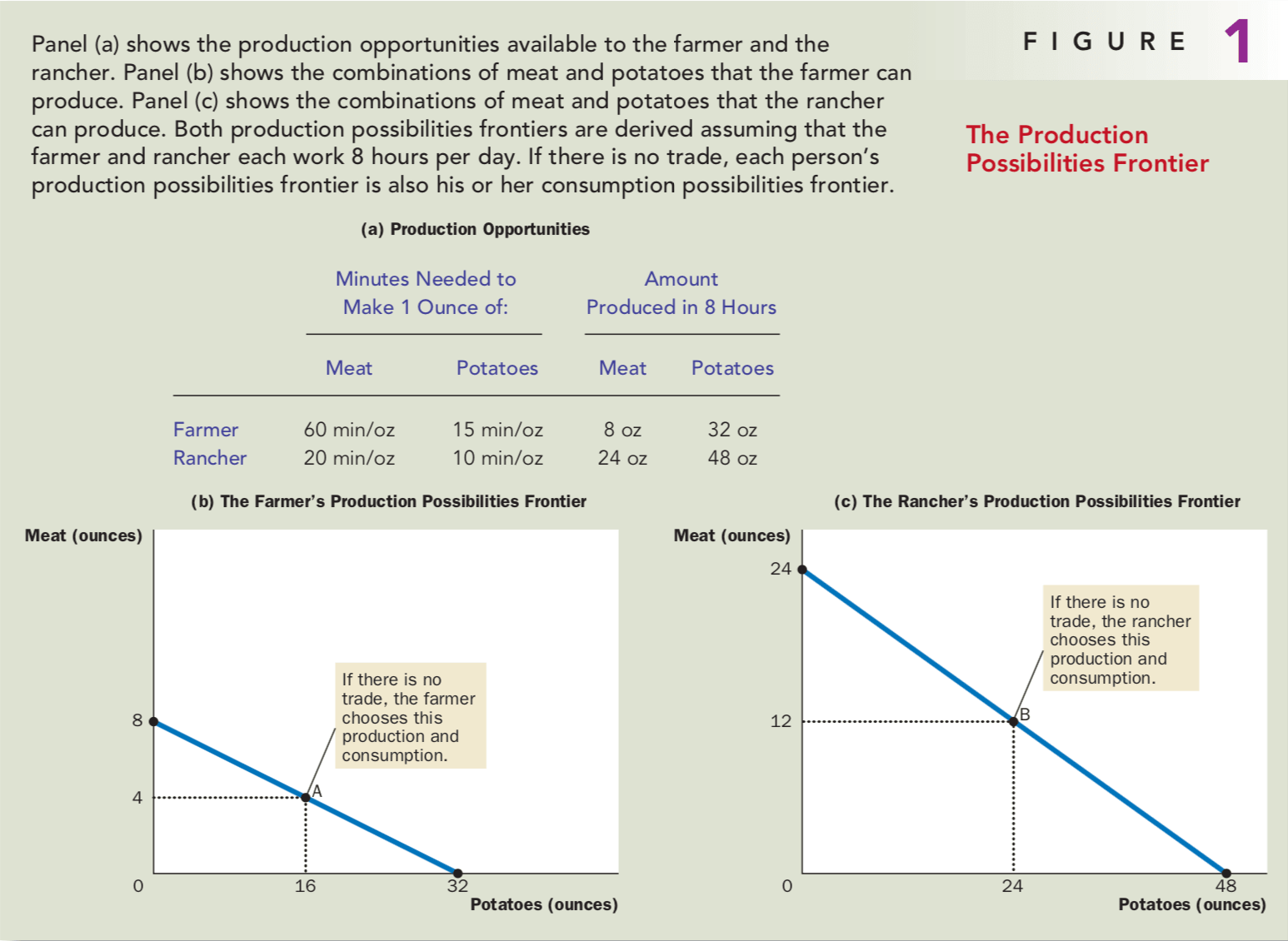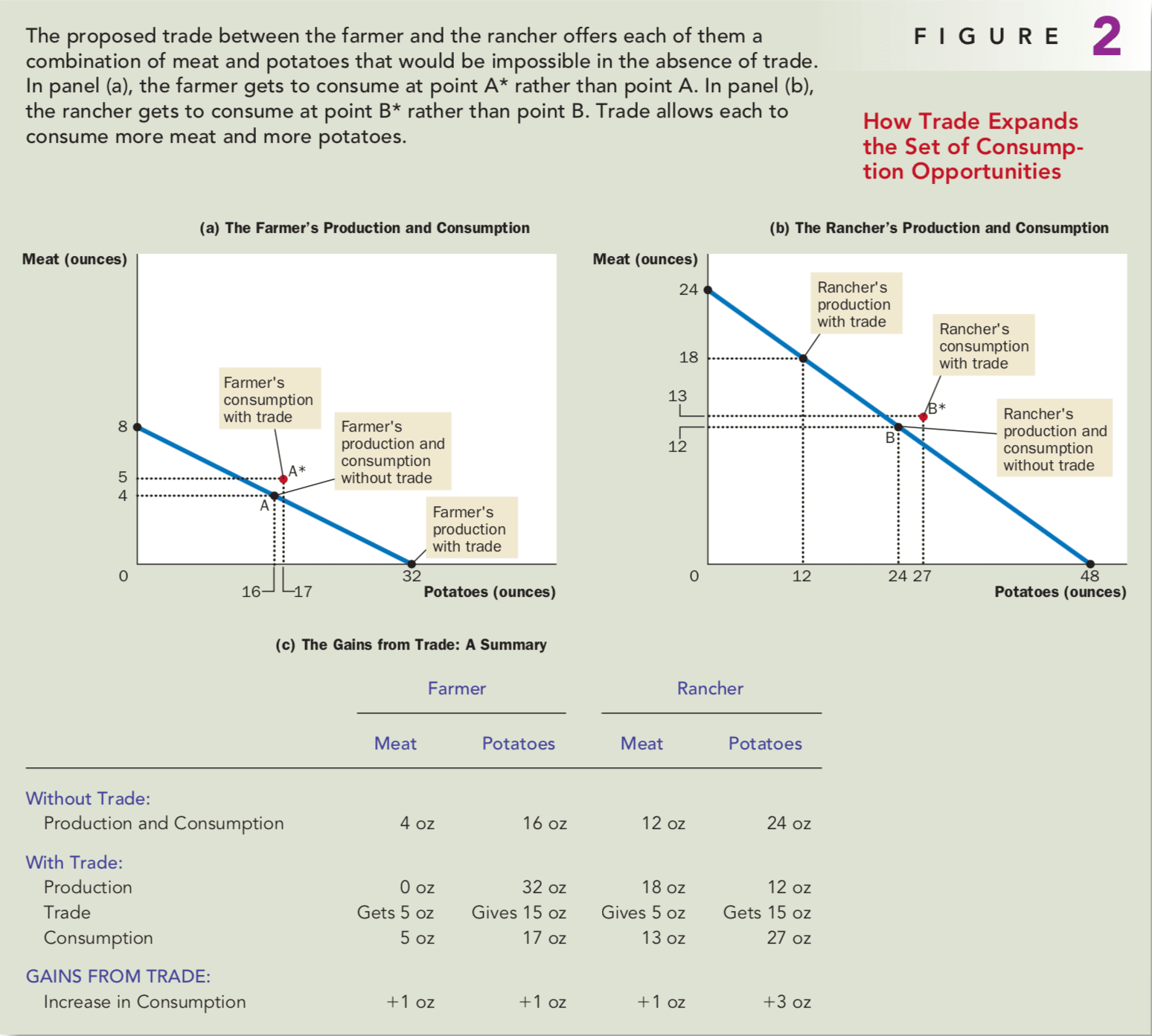Table of Contents
- A Parable for the Modern Economy
- Comparative Advance: The Driving Force of Specialization
- Applications of Comparative Advantage
- Summary
A Parable for the Modern Economy
Production Possibilities
The graph shows the various mixes of output that an economy can produce and illustrate that people face trade-offs.
 If the farmer and rancher do not trade, the production possibilities frontier is also the consumption possibilities frontier. However, the frontier shows trade-offs but do not show what they will choose to do. So let’s suppose the choose the combinations identified in the graph by points A and B.
If the farmer and rancher do not trade, the production possibilities frontier is also the consumption possibilities frontier. However, the frontier shows trade-offs but do not show what they will choose to do. So let’s suppose the choose the combinations identified in the graph by points A and B.
Specialization and Trade
 The farmer and rancher can both benefit because trade allows each of them to specialize in doing what they do best. The farmer will spend more time growing potatoes and less time raising cattle. The rancher will spend more time raising cattle and less time growing potatoes. As a result of specialization and trade, each of them can consume more meat and more potatoes without working any more hours.
The farmer and rancher can both benefit because trade allows each of them to specialize in doing what they do best. The farmer will spend more time growing potatoes and less time raising cattle. The rancher will spend more time raising cattle and less time growing potatoes. As a result of specialization and trade, each of them can consume more meat and more potatoes without working any more hours.
Comparative Advance: The Driving Force of Specialization
The puzzle is why the rancher does better in both fields, he still gain from trade? To solve this puzzle, we should answer first who has a lower cost to produce potatoes?
Absolute Advantage
We can measure the cost through absolute advantage which is the ability to produce a good using fewer inputs than another producer. In our example, the only input is time. Because the rancher need fewer time to produce both items, he has the absolute advantage in producing both goods. Base on this the rancher has a lower cost to produce potatoes.
Opportunity Cost and Comparative Advantage
Recall the opportunity cost is whatever must be given up to obtain some item. In our example, the opportunity cost of the rancher to produce 1 ounce potatoes is 1/2 ounce meat and the opportunity cost of him to produce 1 ounce meat is 2 ounce potatoes. Similarly, we can compute the opportunity cost for farmer which summarize in table 1. 
We can also measure the cost through comparative advantage, which is the ability to produce a good at a lower opportunity cost than another producer. Through table 1 we can find out that farmer has comparative advantage in producing potatoes and rancher has comparative advantage in producing meat. That’s why the rancher can gain from trade.
Although it is possible for one person to have an absolute advantage in both goods, it is impossible for one to have a comparative advantage in both goods. Because the opportunity cost of one good is inverse of the opportunity cost of the other.
Comparative Advantage and Trade
The gains from specialization and trade based on comparative advantage. By specialization in what he has a comparative advantage, the total production of the society raises which means increase the size of economic pie.
Also, the price of the goods should lower than their opportunity cost of producing it. For example, the farmer exchange 15 ounce potatoes for 5 ounce meat. The price of meat for the farmer is 3 ounce potatoes which is lower than his opportunity cost of producing meat (4 ounce potatoes). Similarly, for the rancher, the price of 1 ounce potatoes is 1/3 ounce meat which is also lower than his opportunity cost of producing potatoes (1/2 ounce meat).
Conclude: Trade can benefit everyone in society because it allows people to specialize in activities in which they have a comparative advantage.
The Price and The Trade
For both parties to gain from trade, the price at which they trade must lie between the two opportunity costs.
Applications of Comparative Advantage
Should Tiger Woods Mow His Own Lawn?
Say Tiger Woods can mow his own lawn in 2 hours while, Forrest, the boy next door, can mow the lawn in 4 hours. Should Tiger Woods mow his own lawn?
Clearly, Tiger Woods has an absolute advantage in mowing the lawn but he has a higher opportunity cost in doing it because he could spend 2 hours filming a commercial advertisement earning $10000 while Forrest can only earn $20 in 4 hours. So Tiger should hire Forrest to mow the lawn and both of them will better off as long as the payment is between $20 and $10000.
Should the United States Trade With Other Countries?
International trade can make some individuals worse off, even as it makes the country as a whole better off. When the US exports food and imports cars, the impact on an American farmer is not the same as the impact on an American autoworker. Yet, international trade is not like war, in which some countries win and others lose. Trade allows all countries to achieve greater prosperity.
Summary
- Each person consumes goods and services produced by many other people both in the United States and around the world. Interdependence and trade are desirable because they allow everyone to enjoy a greater quantity and variety of goods and services.
- There are two ways to compare the ability of two people in producing a good. The person who can produce the good with the smaller quantity of inputs is said to have an absolute advantage in producing the good. The person who has the smaller opportunity cost of producing the good is said to have a comparative advantage. The gains from trade are based on comparative advantage, not absolute advantage.
- Trade makes everyone better off because it allows people to specialize in those activities in which they have a comparative advantage.
- The principle of comparative advantage applies to countries as well as to people. Economists use the principle of comparative advantage to advocate free trade among countries.